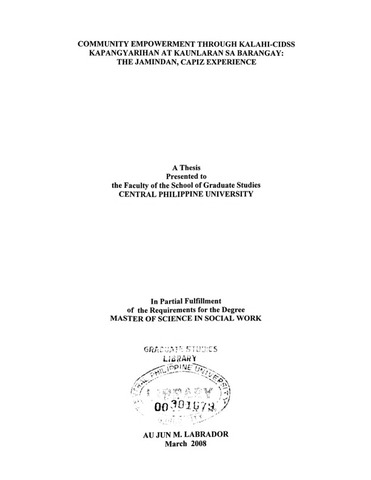Community empowerment through KALAHI-CIDSS Kapangyarihan at Kaunlaran sa Barangay: The Jamindan, Capiz experience

Page views
2,524Date
2008Author
Thesis Adviser
Defense Panel Chair
Share
Metadata
Show full item record
Abstract
This study was conducted to look into the community empowerment of the beneficiaries of KC:KKB project in Jamindan Capiz. This is a descriptive-qualitative research that utilized the one-shot survey design, supplemented with qualitative approaches, such as Focus Group Discussion (FGD) and Key Informant Interview (KII) collecting the data to answer the study objectives. Seven out of thirteen prioritized barangays of KALAHI-CIDSS:KKB Project in Jamindan Capiz were covered by this study. The respondents of the study were the program staff and the community volunteers of the KALAHI-CIDSS: KKB in the seven sample barangays of the Municipality of Jamindan Capiz. An equal number of respondents came from seven participating barangays in the program. The researcher based the interview schedule from the community empowerment indicators of the KALAHI-CIDSS:KKB Project and translated the interview schedule into Hiligaynon for the face-to-face interview.
The collected data were computer processed using the Statistical Package for Social Sciences (SPSS) Version 12. Statistical tools used for descriptive statistics were the frequency distribution and means. Qualitative data gathered through focus group discussion were analyzed descriptively.
Results of the study revealed that all participating respondents were volunteers of KALAHI-CIDSS:KKB Projects. The proposed projects of the seven sample barangays with the highest total project cost and approved grants were the economic support infrastructure projects. The trainings/workshops that were provided in the seven sample barangays were the trainings that capacitate the volunteers on their needed knowledge, skills, and attitudes in order to efficiently and effectively implement the KALAHI CIDSS:KKB process according to its plan of implementation. These are: Municipal Orientation, Participatory Situation Analysis, Municipal Criteria Setting Workshop, 1st MIBF, Procurement, Finance, and Infra Training, 2nd MIBF, Pre Construction Conference, O and M Training, 3rd MIBF (Accountability Forum), Community Based Evaluation, Municipal Sustainability and Planning Workshop.
In the process of implementation, grants were directly downloaded to community accounts of the prioritized barangay who had completely complied with the requirements of request for fund release. Delays were incurred in counter checking request for fund release due to “back to site” findings of the Regional Office on the erroneous presentation and additional attachment on the document of request for fund release.
The BSPMC particularly the supervision of PIT in cooperation with the working foreman were responsible for spearheading the implementation of the Infrastructure project of the community. It was found that the hiring and fielding of the personnel are the jurisdiction of the RPMO. It also decided on the fate of a prospect to be accepted to the KALAHI family also their assigned areas.
The conduct of training/workshops underwent a process that needed follow up in order that the quality of output would be attained. These were the conceptualization of training/workshops, actual conduct of the learning initiatives and its administrative details, and post training activities.
The actual grants provided to the sample barangays depended on the proposed sub project and on the justification of the ACT on the tranching that were based on the community procurement packaging plan that were approved by the Central Office. There was 100 percent physical accomplishment in the infrastructure projects as of Brgys. Molit, Esperanza and San Vicente as of December 2006. The KALAHI-CIDSS:KKB Project personnel assigned in sample barangays were fitted for the job.
There were 425 volunteers who were trained, on Municipal Orientation, Participatory Situation Analysis, Municipal Criteria Setting Workshop, 1st MIBF, Procurement, Finance, and Infra Training, 2nd MIBF, Pre Construction Conference, O and M Training, 3rd MIBF (Accountability Forum), Community Eased Evaluation, Municipal Sustainability and Planning Workshop.
Community empowerment was fully attained. Out of eleven indicators for empowerment, eight indicators had positive responses and only three indicators had negative responses. The collaboration and the active involvement of the community and the LGU were the project facilitators. Too many requirements, political intervention and delayed releases of funds are project constraints.
Description
Abstract only
Suggested Citation
Labrador, Au Jun M. (2008). Community empowerment through KALAHI-CIDSS Kapangyarihan at Kaunlaran sa Barangay: The Jamindan, Capiz experience (Unpublished Master's thesis). Central Philippine University, Jaro, Iloilo City.
Type
ThesisSubject(s)
Department
School of Graduate StudiesDegree
Master of Science in Social WorkShelf Location
GSL Theses 361.30072 L114
Physical Description
xii, 103 leaves
Collections
The following license files are associated with this item:


